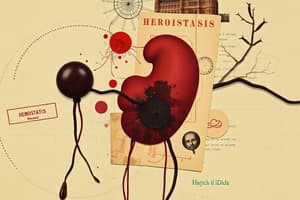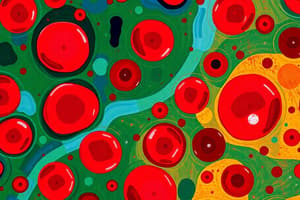Podcast
Questions and Answers
What is used to estimate the cytolytic activity of the NK cells within the cell population?
What is used to estimate the cytolytic activity of the NK cells within the cell population?
- Methanol fixation of the slides
- Counting macrophages with covaspheres
- Release of chromium from radiolabeled target cells (correct)
- Evaluation under a fluorescent microscope
What is included in the Tier I procedures of the NTP 2 Tier Approach for Immunotoxicity Testing?
What is included in the Tier I procedures of the NTP 2 Tier Approach for Immunotoxicity Testing?
- Host resistance studies
- Delayed hypersensitivity response
- Cytotoxic T-lymphocyte (CTL) assay
- Spleen cellularity (correct)
What are the target cells used in the NK Cell Assay?
What are the target cells used in the NK Cell Assay?
- Spleen cells
- YAC lymphoma cells (correct)
- Peripheral mononuclear cells
- Macrophages with covaspheres
What is the function of platelets in the clotting mechanism?
What is the function of platelets in the clotting mechanism?
What is the stem cell for platelets?
What is the stem cell for platelets?
What is thrombocytopenia?
What is thrombocytopenia?
What is thrombotic thrombocytopenic purpura (TTP) characterized by?
What is thrombotic thrombocytopenic purpura (TTP) characterized by?
What is the primary function of Artificially Acquired Active Immunity?
What is the primary function of Artificially Acquired Active Immunity?
What is the main characteristic of Artificially Acquired Passive Immunity?
What is the main characteristic of Artificially Acquired Passive Immunity?
Where are antibodies produced in Humoral Immunity?
Where are antibodies produced in Humoral Immunity?
What is the primary role of T cells in Cell-Mediated Immunity?
What is the primary role of T cells in Cell-Mediated Immunity?
What does Immunological Memory refer to?
What does Immunological Memory refer to?
What does Antibody Titer measure?
What does Antibody Titer measure?
Which type of Hypersensitivity Reaction involves IgE antibodies and mast cell degranulation?
Which type of Hypersensitivity Reaction involves IgE antibodies and mast cell degranulation?
What is the primary mechanism of Type II Cytotoxic Reactions?
What is the primary mechanism of Type II Cytotoxic Reactions?
What is the primary outcome of Type III Immune Complex Reactions?
What is the primary outcome of Type III Immune Complex Reactions?
What is the primary characteristic of Type IV Cell-Mediated Reactions?
What is the primary characteristic of Type IV Cell-Mediated Reactions?
What is the primary outcome of Autoimmunity?
What is the primary outcome of Autoimmunity?
Which phase of hemostasis involves increased circulation to the site, WBCs leaking into tissues, and release of histamine and prostaglandin?
Which phase of hemostasis involves increased circulation to the site, WBCs leaking into tissues, and release of histamine and prostaglandin?
What is the primary mechanism preventing clot growth?
What is the primary mechanism preventing clot growth?
Which condition is characterized by a deficiency in the number of circulating platelets, leading to spontaneous hemorrhage?
Which condition is characterized by a deficiency in the number of circulating platelets, leading to spontaneous hemorrhage?
What is the primary outcome of Disseminated Intravascular Coagulation (DIC)?
What is the primary outcome of Disseminated Intravascular Coagulation (DIC)?
What causes hereditary bleeding disorders known as Hemophilias?
What causes hereditary bleeding disorders known as Hemophilias?
Where are primary immune responses localized?
Where are primary immune responses localized?
What does innate immunity consist of?
What does innate immunity consist of?
Which type of immunity operates against any substance and is present from birth?
Which type of immunity operates against any substance and is present from birth?
What are the types of acquired immunity mentioned in the text?
What are the types of acquired immunity mentioned in the text?
What is the primary characteristic of acquired immunity?
What is the primary characteristic of acquired immunity?
What are substances used to prevent undesirable clots?
What are substances used to prevent undesirable clots?
What may result from the inability to synthesize procoagulants by the liver?
What may result from the inability to synthesize procoagulants by the liver?
What is the primary outcome of Na+ Channel Blockade?
What is the primary outcome of Na+ Channel Blockade?
What is the main effect of K+ Channel Blockade?
What is the main effect of K+ Channel Blockade?
What is the consequence of Ca2+ Channel Blockade?
What is the consequence of Ca2+ Channel Blockade?
What is the result of inhibition of Na+, K+-ATPase?
What is the result of inhibition of Na+, K+-ATPase?
What may result from xenobiotic-induced constriction of the coronary vasculature?
What may result from xenobiotic-induced constriction of the coronary vasculature?
What is the consequence of interference with ion homeostasis in cardiac function?
What is the consequence of interference with ion homeostasis in cardiac function?
What is the primary effect of right-sided heart failure?
What is the primary effect of right-sided heart failure?
What does cardiomyopathy cover?
What does cardiomyopathy cover?
What may result from exposure to a toxin causing high blood pressure and cardiac hypertrophy?
What may result from exposure to a toxin causing high blood pressure and cardiac hypertrophy?
What is the consequence of ischemia-reperfusion injury?
What is the consequence of ischemia-reperfusion injury?
What is the primary effect of elevated Ca2+ levels in cardiotoxic reactions?
What is the primary effect of elevated Ca2+ levels in cardiotoxic reactions?
What is the primary mechanism of xenobiotic-induced ischemia?
What is the primary mechanism of xenobiotic-induced ischemia?
What is the primary result of Na+ Channel Blockade?
What is the primary result of Na+ Channel Blockade?
What may result from xenobiotic-induced constriction of the coronary vasculature?
What may result from xenobiotic-induced constriction of the coronary vasculature?
What is the primary mechanism of Altered Coronary Blood Flow induced by xenobiotics?
What is the primary mechanism of Altered Coronary Blood Flow induced by xenobiotics?
What is the effect of K+ Channel Blockade?
What is the effect of K+ Channel Blockade?
What is the primary outcome of Ischemia-Reperfusion Injury?
What is the primary outcome of Ischemia-Reperfusion Injury?
What is the primary effect of Ca2+ Channel Blockade?
What is the primary effect of Ca2+ Channel Blockade?
What is the primary consequence of Inhibition of Na+, K+-ATPase?
What is the primary consequence of Inhibition of Na+, K+-ATPase?
What is the primary impact of interference with Ion Homeostasis on cardiac function?
What is the primary impact of interference with Ion Homeostasis on cardiac function?
What is the primary outcome of Altered Myocardial Function resulting from exposure to a toxin?
What is the primary outcome of Altered Myocardial Function resulting from exposure to a toxin?
What is the primary impact of right-sided heart failure?
What is the primary impact of right-sided heart failure?
What is the primary characteristic of Cardiomyopathies?
What is the primary characteristic of Cardiomyopathies?
What is the primary consequence of exposure to a toxin causing high blood pressure?
What is the primary consequence of exposure to a toxin causing high blood pressure?
What is the primary contractile unit in cardiac muscle tissue?
What is the primary contractile unit in cardiac muscle tissue?
Which cells in the heart have limited proliferative capacity?
Which cells in the heart have limited proliferative capacity?
What sets the pace of the heart's electrical conduction?
What sets the pace of the heart's electrical conduction?
What does an electrocardiogram (ECG) primarily record?
What does an electrocardiogram (ECG) primarily record?
What regulates cardiac activity by stimulating cardiac rate and contractility?
What regulates cardiac activity by stimulating cardiac rate and contractility?
What is the crucial role of the ATPase sarcoplasmic reticulum pump (SERCA) in cardiac myocytes?
What is the crucial role of the ATPase sarcoplasmic reticulum pump (SERCA) in cardiac myocytes?
What is the measurement of cardiac output (CO) dependent on?
What is the measurement of cardiac output (CO) dependent on?
What may toxicants affect to disturb cardiac function?
What may toxicants affect to disturb cardiac function?
What is the primary characteristic of disturbances in cardiac function?
What is the primary characteristic of disturbances in cardiac function?
What is the consequence of interference with ion homeostasis in cardiac function?
What is the consequence of interference with ion homeostasis in cardiac function?
What is the primary outcome of disturbances in cardiac function?
What is the primary outcome of disturbances in cardiac function?
What may result from toxicants affecting the nervous system in relation to cardiac function?
What may result from toxicants affecting the nervous system in relation to cardiac function?
What is the primary contractile unit in cardiac muscle tissue?
What is the primary contractile unit in cardiac muscle tissue?
Which cells have limited proliferative capacity and promote cardiac fibroblast proliferation?
Which cells have limited proliferative capacity and promote cardiac fibroblast proliferation?
What sets the pace of the heart's electrical conduction?
What sets the pace of the heart's electrical conduction?
What records the electrical currents of the heart?
What records the electrical currents of the heart?
What regulates cardiac activity by stimulating cardiac rate and contractility?
What regulates cardiac activity by stimulating cardiac rate and contractility?
What is the primary ion involved in excitation-contraction coupling in cardiac myocytes?
What is the primary ion involved in excitation-contraction coupling in cardiac myocytes?
What is the measurement dependent on heart rate and stroke volume?
What is the measurement dependent on heart rate and stroke volume?
What is a potential consequence of disturbances in cardiac function?
What is a potential consequence of disturbances in cardiac function?
What is the primary impact of exposure to toxicants affecting the cardiovascular system?
What is the primary impact of exposure to toxicants affecting the cardiovascular system?
What is the primary measurement involved in characterizing cardiac function?
What is the primary measurement involved in characterizing cardiac function?
What is the primary consequence of interference with ion homeostasis in cardiac function?
What is the primary consequence of interference with ion homeostasis in cardiac function?
What is the primary consequence of disturbances in cardiac function?
What is the primary consequence of disturbances in cardiac function?
Flashcards are hidden until you start studying
Study Notes
Acquired Immunity and Immunological Memory
- Artificially Acquired Active Immunity is achieved through vaccination, providing lifelong or temporary immunity.
- Artificially Acquired Passive Immunity involves injecting preformed antibodies, offering short-lived immunity.
- Humoral Immunity involves B cells producing antibodies against foreign antigens, found in extracellular fluids.
- Cell-Mediated Immunity involves T cells recognizing foreign antigens and regulating immune system cells.
- Immunological Memory refers to the immune system's ability to respond more rapidly to subsequent exposures to an antigen.
- Antibody Titer measures the amount of antibodies in the serum, displaying patterns during infection.
- Hypersensitivity Disorders include Type I (Anaphylactic), Type II (Cytotoxic), Type III (Immune Complex), and Type IV (Cell-Mediated) reactions.
- Type I Anaphylactic Reactions involve IgE antibodies, mast cell degranulation, and can lead to anaphylactic shock.
- Type II Cytotoxic Reactions activate complement to lyse antigenic cells, causing transfusion reactions.
- Type III Immune Complex Reactions involve immune complex deposition in organs, leading to diseases like glomerulonephritis.
- Type IV Cell-Mediated Reactions result in delayed hypersensitivity reactions, frequently displayed on the skin.
- Autoimmunity involves the breakdown of self-recognition mechanisms, leading to tissue damage and diseases like scleroderma and lupus.
Hemostasis and Immune System Overview
- Hemostasis involves three phases: vascular spasms, platelet plug formation, and coagulation
- Mechanisms preventing clot growth include swift removal of clotting factors and inhibition of activated clotting factors
- Substances used to prevent undesirable clots include aspirin, heparin, and warfarin
- Disseminated Intravascular Coagulation (DIC) leads to widespread clotting in intact blood vessels, causing blockage of blood flow and severe bleeding
- Thrombocytopenia is a condition where the number of circulating platelets is deficient, leading to spontaneous hemorrhage
- Bleeding disorders may result from the inability to synthesize procoagulants by the liver, caused by conditions such as vitamin K deficiency, hepatitis, or cirrhosis
- Hemophilias are hereditary bleeding disorders caused by a lack of specific clotting factors
- The immune system is localized in primary organs like bone marrow and thymus, and immune responses occur in secondary organs
- Innate immunity consists of physical and chemical barriers, cellular responses, and soluble factors
- The inflammatory response involves increased circulation to the site, WBCs leaking into tissues, and release of histamine and prostaglandin
- Innate immunity is present from birth and operates against any substance, while acquired immunity is tailored to individual pathogens and is enhanced by prior exposure
- Types of acquired immunity include naturally acquired active and passive immunity, as well as artificially acquired immunity through vaccines or immune serum
Cardiac Physiology and Function
- The cardiovascular system consists of the myocardium and a network of vascular vessels (arteries, capillaries, veins) that supply cells and tissues with nutrients and remove waste products.
- The primary contractile unit in cardiac muscle tissue is the cardiac muscle cell (myocyte), which is joined by tight gap junctions facilitating action potential propagation.
- The heart comprises various cellular phenotypes, including myocytes, cardiac fibroblasts, vascular cells, Purkinje cells, and connective tissue cells, with limited proliferative capacity of myocytes and promotion of cardiac fibroblast proliferation.
- The ventricular action potential (AP) overview involves different phases, including resting, initiation, plateau, and re-polarization, with specific ion channels opening and closing during each phase.
- Electrical conduction in the heart involves pacemaker cells such as the sinoatrial (SA) node, atrioventricular (AV) node, bundle of His, and Purkinje fibers, with the SA node commonly setting the pace of the heart.
- The electrical impulse migration from the SA node through the atrial muscle, AV node, and bundle of His allows atria to fully contract before ventricles depolarize.
- An electrocardiogram (ECG) records electrical currents of the heart, with different intervals corresponding to conduction through the AV node, ventricular depolarization and repolarization.
- Cardiac activity is regulated by the autonomic nervous system (ANS), with sympathomimetics stimulating cardiac rate and contractility, and parasympathomimetics decreasing the rate of depolarization.
- Excitation-contraction coupling in cardiac myocytes involves the availability of ATP and Ca2+ for contraction and relaxation, with the ATPase sarcoplasmic reticulum pump (SERCA) playing a crucial role.
- Cardiac function is characterized by the recording of electrical currents through an ECG and the measurement of cardiac output (CO) which is dependent on heart rate and stroke volume, typically around 5L/min.
- Toxicants can affect cardiac function through their effects on the heart, vasculature, and/or the nervous system, potentially leading to disturbances in heart rhythm, such as arrhythmias.
- Disturbances in cardiac function may include abnormal heart rhythm, ischemic heart disease, cardiac hypertrophy, and heart failure, with potential implications for myocardial infarction, scar tissue formation, and reduced cardiac output.
Studying That Suits You
Use AI to generate personalized quizzes and flashcards to suit your learning preferences.




